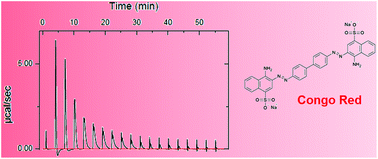Calorimetric and spectroscopic detection of the interaction between a diazo dye and human serum albumin†
Abstract
Dye effluents are one of the main causes of water pollution. Azo dyes, the most widely applied colorants, are particularly difficult to degrade. Exposure of such dyes to the aquatic environment is hazardous to human health and biota due to their intrinsic harmful mutagenic and carcinogenic properties. Congo Red (CR) is an anionic and synthetic diazo dye, which is recalcitrant to the biodegradative process and metabolizes to produce a potential carcinogen. Research on the interaction of this toxic dye with serum albumin, as a transport protein, is of paramount significance because the physiological and toxicological behaviours of the dye in vivo are associated with its interactive characteristics with the proteins. In this regard, a detailed binding profile of CR with human serum albumin (HSA) was studied using isothermal titration calorimetry (ITC) along with various spectroscopic and microscopic methods. The thermodynamic results from ITC indicated that the CR–HSA non-covalent interaction occured primarily due to favorable entropy and unfavorable enthalpy with a Ka of 106 M−1 at lower concentrations and 105 M−1 at higher concentrations. Steady-state fluorescence data revealed that the intrinsic fluorescence of HSA was quenched in the presence of CR via the static quenching mechanism. Using Förster's non-radioactive energy transfer theory (FRET), the specific binding distance r (2.73 nm) between the donor (Trp-214 from HSA) and the acceptor (CR) was calculated. Our preliminary results indicated that CR had a high affinity to HSA, which can have significant implications in the distribution and elimination of this toxic dye upon exposure.



 Please wait while we load your content...
Please wait while we load your content...